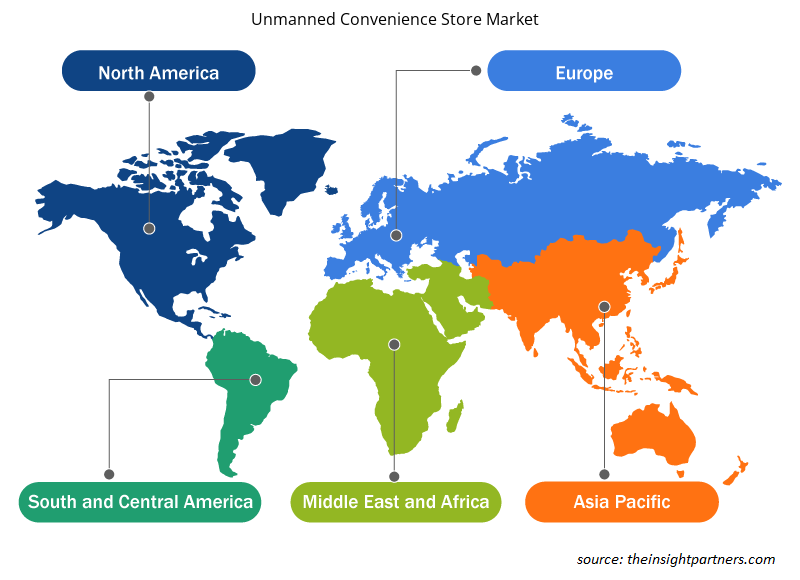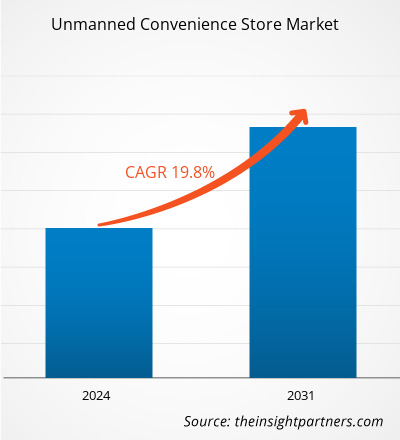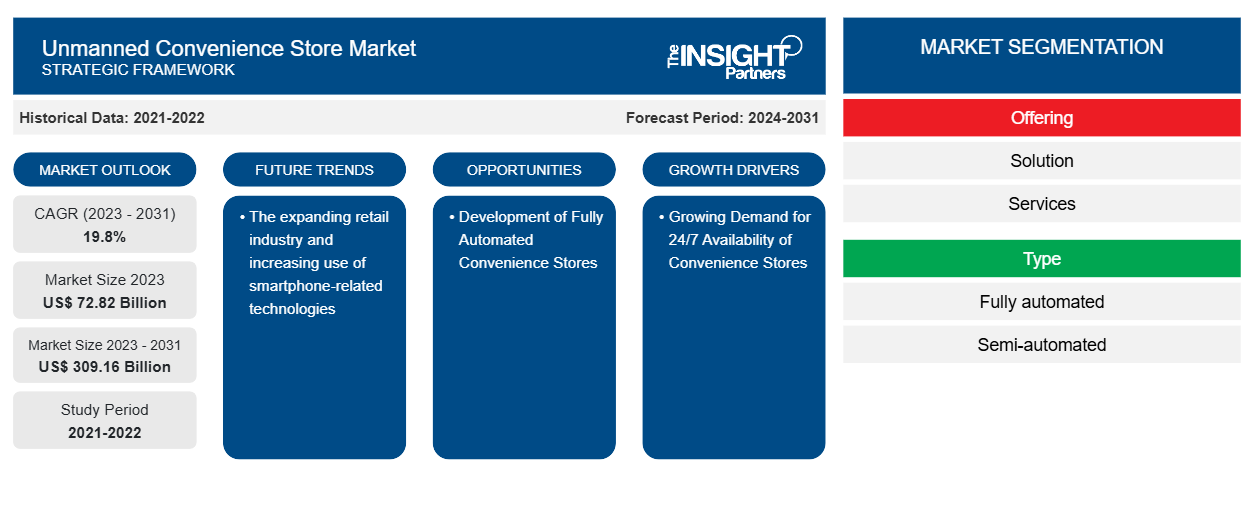무인 편의점 시장 규모는 2023년 728억 2,000만 달러에서 2031년 3,091억 6,000만 달러로 성장할 것으로 예상됩니다. 이 시장은 2023~2031년 에 19.8%의 CAGR을 기록할 것으로 예상됩니다 . 확장되는 소매 산업과 스마트폰 관련 기술의 사용 증가는 무인 편의점 시장의 주요 트렌드로 남을 가능성이 높습니다.
무인 편의점 시장 분석
무인 편의점 시장은 편의점 의 24시간 연중무휴 가용성에 대한 수요 증가 와 소비자들 사이에서 쇼핑 편의성에 대한 수요 증가로 인해 빠른 속도로 성장하고 있습니다. 시장은 소비자 경험을 향상시켜 비용을 최적화하려는 비즈니스 요구가 증가함에 따라 꾸준히 확장되고 있습니다. 게다가, 기술의 발전과 완전 자동화된 편의점의 개발은 시장 성장을 위한 수익성 있는 기회를 제공하고 있습니다.
무인 편의점 시장 개요
무인 편의점은 계산원이 없고 고객 상담원이 매장에 물리적으로 존재하지 않는 유형의 소매점입니다. 이러한 매장은 인공 지능 및 스마트폰 관련 기술과 같은 첨단 기술을 사용하여 일상 활동과 거래를 관리합니다. 무인 편의점은 소비자가 언제 어디서나 식료품이나 약국 용품과 같은 빠르게 움직이는 상품을 편리하게 구매할 수 있도록 만들어졌습니다. 그러나 이러한 매장이 제공하는 상당한 이점, 즉 24시간 연중무휴 이용 가능, 편의성, 기술 통합, 셀프 서비스 및 셀프 체크아웃, 소비자와 서비스 제공자 모두에게 비용 절감이 시장을 촉진합니다.
귀하의 요구 사항에 맞게 이 보고서를 사용자 정의하세요
이 보고서의 일부 또는 국가 수준 분석, Excel 데이터 팩을 포함하여 모든 보고서에 대한 사용자 정의를 무료로 받을 수 있으며 신생 기업 및 대학을 위한 훌륭한 혜택과 할인 혜택을 이용할 수 있습니다.
-
이 보고서의 주요 시장 동향을 알아보세요.이 무료 샘플에는 시장 동향부터 추정 및 예측까지 다양한 데이터 분석이 포함됩니다.
무인 편의점 시장 동인 및 기회
편의점의 24시간 연중무휴 이용 가능에 대한 수요 증가가 시장을 주도하고 있습니다.
글로벌 무인 편의점 산업은 향상된 고객 경험과 함께 편의성에 대한 요구가 커지면서 확장되고 있습니다. 고객은 긴 줄을 서거나 실제 매장을 방문하지 않고도 언제든지 제품과 서비스에 액세스할 수 있기를 원합니다. 이로 인해 소비자의 요구를 충족하기 위한 무인 편의점에 대한 수요와 개발이 증가합니다. 무인 편의점은 이러한 수요를 충족하기 위해 직원이 거기에 있을 필요 없이 소비자가 24시간 상품과 서비스에 액세스할 수 있도록 합니다. 무인 매장은 직원에게 지불하는 비용을 줄여주기 때문에 기업에 재정적으로 유리한 선택입니다. 이러한 요인은 예측 기간 동안 시장을 활성화할 것으로 예상됩니다.
완전 자동화된 편의점 개발 - 무인 편의점 시장의 기회
디지털화가 확대 되고 기업에서 자율성에 대한 수요가 증가하면서 시장에서 기회가 창출되고 있습니다. 자율 운영을 사용하는 기업은 매장에서 직원이 물리적으로 존재하지 않게 함으로써 인건비를 절감할 수 있습니다. 이를 통해 기업은 광고, 제품 추천, 고객 지원과 같은 다른 영역에 집중하고 노력을 기울일 수 있습니다. 자동화를 통해 무인 편의점은 보안 위험과 보험 비용을 낮출 수 있습니다. 그러나 도난이나 손상에 취약하지 않은 완전 자동화 편의점에 대한 수요와 개발이 증가하면서 시장 성장에 상당한 기회가 창출되고 있습니다.
무인 편의점 시장 보고서 세분화 분석
무인 편의점 시장 분석에 기여한 주요 세그먼트는 제품과 유형입니다.
- 제공에 따라 무인 편의점 시장은 솔루션과 서비스로 나뉩니다. 솔루션 세그먼트는 2023년에 더 큰 시장 점유율을 차지했습니다.
- 유형별로 보면 무인 편의점 시장은 완전 자동화와 반자동으로 구분됩니다. 완전 자동화 부문은 2023년에 더 큰 시장 점유율을 차지했습니다.
지역별 무인 편의점 시장 점유율 분석
무인 편의점 시장 보고서의 지리적 범위는 주로 북미, 아시아 태평양, 유럽, 중동 및 아프리카, 남미/남중미의 5개 지역으로 나뉩니다.
매출 측면에서 북미 시장은 비대면 구매 경험과 편의성에 대한 요구가 커지면서 무인 편의점 시장 점유율이 가장 높았습니다. 북미 시장은 체크아웃 프로세스를 자동화하기 위한 로봇 기술과 인공 지능 기술의 사용이 증가함에 따라 주도되고 있습니다. 게다가 모바일 결제 수단이 출시되면서 소비자는 계산원과 상호 작용하지 않고도 쇼핑을 할 수 있게 되었고, 이는 시장을 활성화하고 있습니다.
무인 편의점 시장 지역별 통찰력
Insight Partners의 분석가들은 예측 기간 동안 무인 편의점 시장에 영향을 미치는 지역적 추세와 요인을 철저히 설명했습니다. 이 섹션에서는 북미, 유럽, 아시아 태평양, 중동 및 아프리카, 남미 및 중미의 무인 편의점 시장 세그먼트와 지리에 대해서도 설명합니다.

- 무인 편의점 시장에 대한 지역별 특정 데이터 얻기
무인 편의점 시장 보고서 범위
| 보고서 속성 | 세부 |
|---|---|
| 2023년 시장 규모 | 728억 2천만 달러 |
| 2031년까지 시장 규모 | 3091억 6천만 달러 |
| 글로벌 CAGR (2023-2031) | 19.8% |
| 역사적 데이터 | 2021-2022 |
| 예측 기간 | 2024-2031 |
| 다루는 세그먼트 |
제공함으로써
|
| 포함된 지역 및 국가 |
북아메리카
|
| 시장 선도 기업 및 주요 회사 프로필 |
|
무인 편의점 시장 참여자 밀도: 비즈니스 역학에 미치는 영향 이해
무인 편의점 시장은 소비자 선호도의 변화, 기술 발전, 제품의 이점에 대한 인식 증가와 같은 요인으로 인해 최종 사용자 수요가 증가함에 따라 빠르게 성장하고 있습니다. 수요가 증가함에 따라 기업은 제품을 확장하고, 소비자의 요구를 충족하기 위해 혁신하고, 새로운 트렌드를 활용하여 시장 성장을 더욱 촉진하고 있습니다.
시장 참여자 밀도는 특정 시장이나 산업 내에서 운영되는 회사나 기업의 분포를 말합니다. 주어진 시장 공간에 얼마나 많은 경쟁자(시장 참여자)가 존재하는지 그 규모나 전체 시장 가치에 비해 나타냅니다.
무인 편의점 시장에서 운영되는 주요 회사는 다음과 같습니다.
- Amazon.com 주식회사
- 심천 라킨다 테크놀로지 유한회사
- F5 퓨처 스토어
- 빙고박스
- CYB-ORG
- 7-Eleven 숍앤고
면책 조항 : 위에 나열된 회사는 어떤 특별한 순서에 따라 순위가 매겨지지 않았습니다.

- 무인 편의점 시장 주요 주요 업체 개요 알아보기
무인 편의점 시장 소식 및 최근 동향
무인 편의점 시장은 1차 및 2차 조사 후 질적, 양적 데이터를 수집하여 평가합니다. 여기에는 중요한 기업 간행물, 협회 데이터 및 데이터베이스가 포함됩니다. 다음은 무인 편의점 시장의 개발 및 전략 목록입니다.
- 2024년 2월, 7-Eleven Shop & Go는 도쿄 및 기타 지역에 무인 편의점을 오픈할 계획입니다. 이 무인 편의점은 스마트폰 결제를 사용하여 운영을 간소화합니다. (출처: Nikkei Inc., 보도자료, 2023)
무인 편의점 시장 보고서 범위 및 제공물
"무인 편의점 시장 규모 및 예측(2021-2031)" 보고서는 아래 영역을 포괄하는 시장에 대한 자세한 분석을 제공합니다.
- 범위에 포함된 모든 주요 시장 세그먼트에 대한 글로벌, 지역 및 국가 수준의 시장 규모 및 예측
- 동인, 제약 및 주요 기회와 같은 시장 역학
- 주요 미래 트렌드
- 자세한 PEST/포터의 5가지 힘과 SWOT 분석
- 주요 시장 동향, 주요 업체, 규정 및 최근 시장 동향을 포괄하는 글로벌 및 지역 시장 분석
- 시장 집중도, 히트맵 분석, 유명 기업 및 최근 개발 사항을 포함하는 산업 환경 및 경쟁 분석
- 자세한 회사 프로필
- 과거 분석(2년), 기준 연도, CAGR을 포함한 예측(7년)
- PEST 및 SWOT 분석
- 시장 규모 가치/거래량 - 글로벌, 지역, 국가
- 산업 및 경쟁 환경
- Excel 데이터세트
최근 보고서
사용 후기
구매 이유
- 정보에 기반한 의사 결정
- 시장 역학 이해
- 경쟁 분석
- 고객 인사이트
- 시장 예측
- 위험 완화
- 전략 기획
- 투자 타당성 분석
- 신흥 시장 파악
- 마케팅 전략 강화
- 운영 효율성 향상
- 규제 동향에 발맞춰 대응























 무료 샘플 받기 - 무인 편의점 시장
무료 샘플 받기 - 무인 편의점 시장